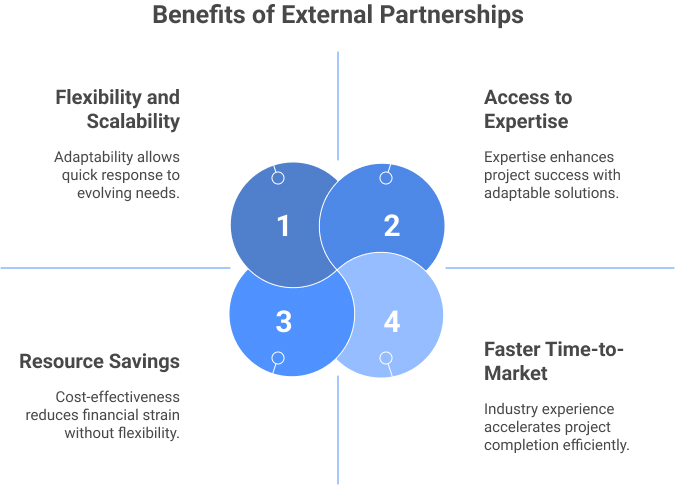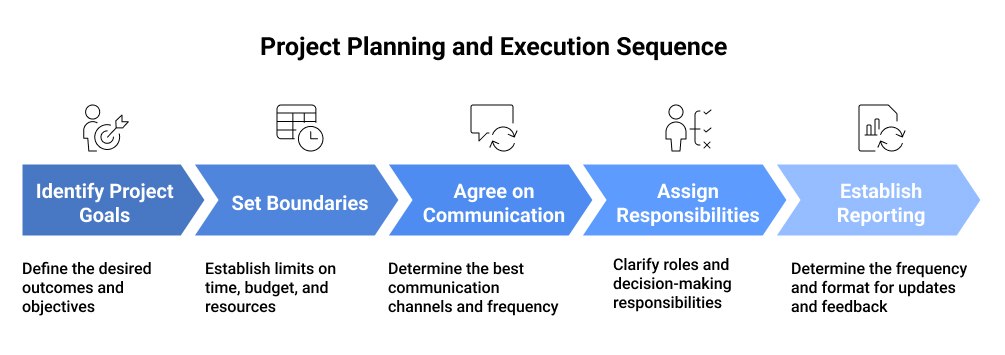
Engaging an external development team is no longer just about capacity – it’s a strategic lever for speed, specialization, and flexibility. Whether you’re launching a new product or scaling existing solutions, the right partner can accelerate delivery and reduce operational overhead.
Why Companies Choose External Partners
Engaging an external development team offers significant advantages, but success hinges on choosing the right partner and setting clear expectations from the start. Here’s why companies typically turn to external teams:
- Resource Savings: Partnering with specialists allows companies to save on internal costs and reduce the time spent hiring new employees.
- Faster Time-to-Market: Working with partners who have experience in your industry enables you to execute projects much more quickly.
- Access to Expertise: Your team may not have deep knowledge in a specific technology, but external experts provide exactly what’s needed for successful implementation.
- Flexibility and Scalability: Partners can adapt their resources to meet changing project requirements, allowing businesses to quickly respond to new challenges.

Despite the benefits, success is not guaranteed. Collaboration with an external partner can come with risks, which often arise from poor communication, neglected details, or disorganized processes. Fortunately, most of these challenges can be avoided by establishing clear guidelines and expectations at the start of the partnership.
At Developex, we’ve built and led dev teams for global brands and fast-growing product companies. After 20+ years in technical partnerships, we’ve seen the patterns – both the ones that lead to long-term success and the ones that cause friction.
In this post, we’ll cover the most common pitfalls and how to avoid them – based on real experience, not assumptions.
Common Pitfalls When Working with an External Development Partner
While external partnerships offer tremendous potential, there are several common pitfalls that can derail the process. These challenges often arise when expectations aren’t clearly defined or communication isn’t effectively managed. Here are the key pitfalls to watch out for, along with practical solutions to help you avoid them.
1. Unclear Expectations and Inadequate Planning at the Start
One of the most common pitfalls is starting a project without clearly defined expectations. Misunderstanding the final goals, long-term product roadmap, budget constraints, timelines, or communication formats can lead to chaotic changes, rework, and cost overruns. Even the best teams can’t succeed without a clear vision and plan.
Tip: Clarify the following before you begin:
- What will be considered a “successful outcome”?
Define the exact results you expect: a product launch, specific technical achievements, or reliability and stability? - What are the limits on time, budget, and resources?
Set clear boundaries and plan for potential risks with some buffer. - What communication format works best for both sides?
Agree on channels and meeting frequency: daily standups, weekly reports, or regular demos? - Who is responsible for what (roles and responsibilities)?
Clarify decision-making responsibilities for technical aspects, risk management, and key deliverables. - What are your expectations for reporting, feedback, and updates?
Determine the frequency and format for status updates and feedback loops.

Even a basic, documented agreement can significantly reduce misunderstandings and ensure a smoother collaboration.
2. Lack of or Overload Internal Product Owner
The Product Owner is a critical link between the external developer and your company. Without this person who can make business decisions quickly and keep a finger on the pulse of the project, the external partner is forced to act “blindly”, without a clear indication of product development priorities and strategy. This often leads to the development team either taking unnecessary steps or wasting time on functions that are not critical to the business.
Tip: Assign a separate person with sufficient time and authority to fulfill the role of Product Owner. Their task is to maintain the product vision, quickly respond to team questions, prioritize functionality, and regulate changes in requirements. This will allow you to maintain focus on important tasks and provide clear guidance for the external partner, which will significantly reduce the risk of misunderstandings and losses.
3. Incorrect Collaboration Model
A fixed-price model might seem like a safe choice at first, but it can quickly become problematic when requirements are fluid or likely to change. In such cases, a rigid contract can lead to inefficiencies, scope creep, and budget overruns, as the external team struggles to adjust to shifting demands.
Tip: For dynamic projects, consider opting for a Time & Materials (T&M) model. In this model, payment is based on the actual time and resources spent, which allows you to adjust the scope of work without significant problems. Be sure to clearly define how changes in scope will be managed, what constitutes a “change in requirements,” and how these adjustments will affect both budget and timelines. You can also agree on a budget cap for the contract or a specific phase, or set clear spending limits to stay in control while keeping flexibility. This ensures both parties stay aligned and can manage the project’s evolution effectively.
4. Lack of Transparent Feedback and Clear Communication
When the external team operates in isolation with little to no regular feedback or transparent reporting, misunderstandings can quickly accumulate. This communication gap can lead to frustration, missed expectations, and unnecessary rework. Without proper interaction and visibility into the project’s progress, it’s difficult to stay aligned and on track.
Tip: Integrate the external team into your work environment through tools like Slack, daily or weekly calls, or demo sessions. Don’t shy away from providing honest, constructive feedback. Be proactive in understanding how your partner manages reporting – agree on the frequency, format, and content of reports in advance. This helps ensure clarity and keeps everyone on the same page, reducing the potential for miscommunication.
5. Decision-Making Vacuum or Gaps in Technical Expertise
When a client’s team lacks strong technical expertise, it becomes difficult to validate architectural decisions or critically assess the partner’s technical proposals. Without quick, informed feedback, projects can drift off course – leading to solutions that are misaligned with the product’s vision, scalability needs, or long-term strategy.
Tip: If you don’t have an internal technical lead, bring in an external consultant or ensure your development partner can provide senior-level architectural expertise. Clearly define who will own key technical decisions, review critical milestones, and maintain the architectural integrity of the product. A designated technical authority prevents costly missteps and accelerates confident, well-grounded development.
6. Choosing a Partner Without Domain-Specific Expertise
Even the most skilled partner can face challenges if they don’t have experience in your specific industry. Lack of knowledge about the specifics of your product or market can lead to delays in the adaptation phase, additional time spent on communication and adaptation of technical solutions, which will ultimately complicate the development process.
Tip: Choose partners who have experience working with similar types of devices, software, or products in your industry. Such experience will significantly reduce the adaptation time, allow you to understand the requirements faster, and minimize errors in technical solutions. When the partner is already familiar with the specifics of your domain, he will be able to make more accurate proposals and navigate specific requirements, which will ensure the smooth development of the project.
7. High Dependency on a Single Developer and Lack of Knowledge Transfer
When all the critical knowledge and experience of a project is concentrated in the hands of one key developer, this creates a serious risk to the continuity of the project. The departure, illness, or shift in availability of such a specialist can lead to significant delays or even a shutdown of work, as other team members do not have the necessary information to continue development.
Tip: Make sure that the team practices code reviews, knowledge rotation, and has internal documentation describing the architecture and CI/CD processes. This will allow you to preserve critical knowledge within the team and reduce dependence on individual specialists. Ask your partner what the system looks like for replacing key specialists to be sure that, if necessary, the project will continue to move forward without significant difficulties.
8. Unclear Intellectual Property (IP) Ownership
Ambiguities around who owns the code, documentation, or product components can lead to serious legal and business issues later. Without clear agreements, you risk losing control over your own product or facing disputes that could delay growth, investment, or market expansion.
Tip: Ensure that all rights to the code, documentation, and deliverables are clearly transferred to you, or that any exceptions are explicitly outlined. Discuss these issues from the very beginning and record them in the contract. This is especially important for custom solutions, where we are talking about unique developments, and not just modifications to existing software. A clear definition of intellectual property will help avoid disputes in the future and provide you with control over the results of the work.
Final Thoughts: How Developex Approaches Partnerships
At Developex, we’ve learned firsthand what makes partnerships truly successful. With over 20 years of experience in developing custom software solutions, we focus on building real collaboration from day one: clear expectations, flexible cooperation models, embedded team communication, and mature delivery processes.
Whether you need to scale a team, bring in specialized expertise, or accelerate product development, we tailor our approach to fit your goals – not the other way around.
Curious to see how it works in practice? Let’s schedule a short call to discuss our project or explore what our clients say about the impact we’ve made.






